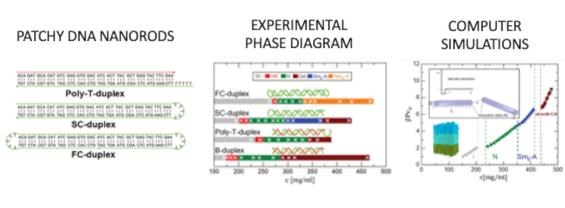Self-Assembly of All-DNA Rods with Controlled Patchiness

Double-stranded DNA (dsDNA) fragments exhibit noncovalent attractive interactions between their tips. It is still unclear how DNA liquid crystal self-assembly is affected by such blunt-end attractions. It is demonstrated that stiff dsDNA fragments with moderate aspect ratio can specifically self-assemble in concentrated aqueous solutions into different types of smectic mesophases on the basis of selectively screening of blunt-end DNA stacking interactions. To this end, this type of attractions are engineered at the molecular level by constructing DNA duplexes where the attractions between one or both ends are screened by short hairpin caps. All-DNA bilayer and monolayer smectic-A type of phases, as well as a columnar phase, can be stabilized by controlling attractions strength. The results imply that the so far elusive smectic-A in DNA rod-like liquid crystals is a thermodynamically stable phase. The existence of the bilayer smectic phase is confirmed by Monte-Carlo simulations of hard cylinders decorated with one attractive terminal site. This work demonstrates that DNA blunt-ends behave as well-defined monovalent attractive patches whose strength and position can be potentially precisely tuned, highlighting unique opportunities concerning the stabilization of nonconventional DNA-based lyotropic liquid crystal phases assembled by all-DNA patchy particles with arbitrary geometry and composition.
More info:
